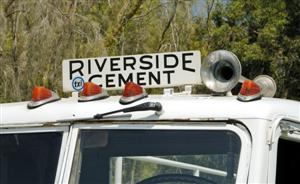COVER FEATURE - NOVEMBER 2006
WHITE GOLD
Riverside
Cement Celebrates 100 Years
By Daniel J. Linss
- Editor
Some might say that the old Autocar pictured on these pages is “white gold” but for Riverside Cement, it was the limestone. Riverside Cement’s Crestmore Facility has produced gray and white cement for over a century. For a time, they were the only company mining white limestone west of Houston, and they became known for their high-quality white cement. Over the years, the company has been bought and sold by many business entities, the latest being TXI out of Texas. Back on August 23, 2006 the plant hit a milestone and celebrated its 100th anniversary!
To most people, cement is something you pour for a driveway or foundation – not true! Cement is the “magic glue” that sticks rock and sand together to make concrete and that is what you pour under and in front of your house. The cement this plant produces requires enormous amounts of just the right materials from the earth, immense machinery to process it, and skilled manpower to transform it into a product which is consumed throughout the world in millions of tons per year.
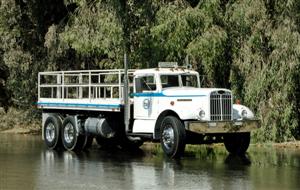 Tracing
the story of cement reveals its verified origins before the birth of Christ.
Arches in the pyramids of Egypt and structures such as the Forum and the
Coliseum erected during the Roman Empire, stand as mute but manifest evidence
that the “magic glue” binding properties of limes were known to man in
his earliest days. The first stone building materials were a variety of
mortars, a mixture of limes, sand and water. Later, crushed brick and
tile were added to the mortar, producing concrete.
Tracing
the story of cement reveals its verified origins before the birth of Christ.
Arches in the pyramids of Egypt and structures such as the Forum and the
Coliseum erected during the Roman Empire, stand as mute but manifest evidence
that the “magic glue” binding properties of limes were known to man in
his earliest days. The first stone building materials were a variety of
mortars, a mixture of limes, sand and water. Later, crushed brick and
tile were added to the mortar, producing concrete.
In the centuries that followed, many craftsmen working independently made the discovery that some limes are hydraulic, that is, when crushed they will harden under water. In the 18th and 19th centuries, men such as John Smeaton in England, Canvass White in the United States, and Joseph Aspdin, an English bricklayer, made important discoveries pertaining to the hydraulic characteristics of burned limestone either blended with other materials such as gypsum and clay or containing amounts of lime, silica and alumina. It was Aspdin’s patented product, which to him resembled the stone quarried on the island of Portland, England that provided the industry with the name, Portland cement. Today, Portland cement refers to certain hydraulic cements, manufactured under the most exacting quality controls, from very carefully selected and proportioned raw materials.
The production of cement in the Riverside area of Southwestern California dates back to 1843, when a Mexican-Indian settlement was founded near the banks of the Santa Ana River. The community at Agua Mansa began mining limestone from the quarries which now produce cement. They made crude kilns by tunneling into the bluffs and sinking vent stacks from the cliff tops. The cement produced was used to coat the walls of their adobe houses. This quarry, after being abandoned by the Indians for many years, was rediscovered in 1895. A small marble quarry, named the Sky Blue Quarry, was developed but the operation ultimately failed because the quarry did not yield large enough slabs of marble.
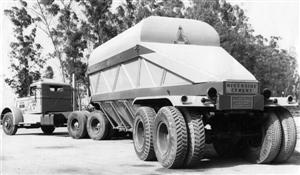 In
1905, Ira Judson Coe, a cement man from Pennsylvania, came to Riverside’s
Crestmore area in search of cement quarries, and found the abandoned Sky
Blue Quarry. As the largest producer of cement in Southern California,
Riverside Cement Company had its origin in the Southern California Cement
Company, which was incorporated by Mr. William G. Henshaw on August 23,
1906. Construction of a 6-kiln plant began almost immediately, and three
years later, in November of 1909, the company’s first cement was produced.
The company’s name changed to Riverside Portland Cement Company on December
29, 1909. On June 1, 1923 the company purchased Golden State Portland
Cement Company located in Oro Grande near Victorville, California. Another
name change was made on April 10, 1928 to Riverside Cement Company – a
name that finally stuck!
In
1905, Ira Judson Coe, a cement man from Pennsylvania, came to Riverside’s
Crestmore area in search of cement quarries, and found the abandoned Sky
Blue Quarry. As the largest producer of cement in Southern California,
Riverside Cement Company had its origin in the Southern California Cement
Company, which was incorporated by Mr. William G. Henshaw on August 23,
1906. Construction of a 6-kiln plant began almost immediately, and three
years later, in November of 1909, the company’s first cement was produced.
The company’s name changed to Riverside Portland Cement Company on December
29, 1909. On June 1, 1923 the company purchased Golden State Portland
Cement Company located in Oro Grande near Victorville, California. Another
name change was made on April 10, 1928 to Riverside Cement Company – a
name that finally stuck!
Riverside Cement was the fastest growing company in Riverside County during the 1940’s when defense projects called for greater amounts of cement. From 1958 to 1998, the company changed owners and/or names some eight times, ultimately falling under the umbrella of Texas Industries (TXI), a huge corporation that owns and operates several aggregate businesses, including three other major cement plants, batch plants across the country, two steel plants, real estate and an aviation company that leases corporate jets, to name just a few.
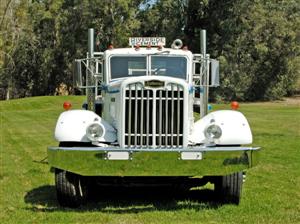 The
processes required to make cement is rather interesting. First, they take
finely ground limestone, iron ore, clay and silica sand and put it in
a kiln set at over 2,000 degrees to burn off the impurities and cause
a chemical reaction that transforms the four types of rock into one. A
small white marble called clinker is produced. Next, the clinker is mixed
with 5% gypsum and ground in mills to a fine powder. From there, it can
be bagged and sold or it can be trucked to a batch plant where gravel,
sand and water are added to it to make concrete.
The
processes required to make cement is rather interesting. First, they take
finely ground limestone, iron ore, clay and silica sand and put it in
a kiln set at over 2,000 degrees to burn off the impurities and cause
a chemical reaction that transforms the four types of rock into one. A
small white marble called clinker is produced. Next, the clinker is mixed
with 5% gypsum and ground in mills to a fine powder. From there, it can
be bagged and sold or it can be trucked to a batch plant where gravel,
sand and water are added to it to make concrete.
In the early days of Riverside Cement, most of the raw materials, including the limestone, were brought in by truck and rail from other local quarries and their sister quarry in Oro Grande. But when a huge limestone deposit was discovered under the plant, an aggressive mining project began at Crestmore. This limestone deposit, the single largest solid piece ever found, stretches from Colton, California (near San Bernardino) southwest along the Santa Ana River to the city of Norco some 20 miles away. The depth of this deposit was never realized but the quality was unsurpassed. The mine produced a very high-quality limestone used to make white cement – a specialty product used for architectural elements, swimming pools and such. In fact, the famous pyramid-shaped Transamerica Tower in San Francisco, California was constructed entirely using white cement from the Crestmore plant.
Riverside Cement was granted the mining rights to everything below the surface, and Colton Cement, which still operates today, was granted rights to everything above. If you have ever driven on Interstate 10 through Colton, California (just east of Fontana near the junction of the 215) and seen the rock mountain that stands alone and has been shrinking for decades, than you have seen Colton Cement’s operation (many call that dwindling mountain “the toe” for obvious reasons). The Crestmore mine was enormous. The entrance was large enough to drive two tractor-trailers, side by side, into the mine. It took 20 minutes to drive (traveling at 5 mph) down to where the main crusher was located. The mine encompassed over 60 miles of spiraling tunnels and rooms, some as large as 100 feet long by 100 feet wide and 60 feet high, and was over 1,700 feet deep.
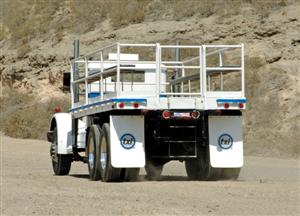 Water
was always a problem in the mine. Workers continuously ran pumps to remove
the unwanted water, but in 1985 a mining mishap punctured an aquifer some
forty stories beneath the surface, causing massive amounts of water to
rush into the mine (they hit the Santa Ana River). The pumps could not
keep up with the 30,000 gallons of water per minute that was entering
the mine, so they shut them down and abandoned the tunnels. It took six
months, but the entire mine filled with water and then a 200-foot deep
lake accumulated over the opening. Today, that lake (Lake Crestmore),
located on Riverside Cement’s property next to the plant, is stocked with
fish and has a small dock. Crestmore employees have formed a Rod and Reel
Club, and enjoy fishing at the lake on their leisure time.
Water
was always a problem in the mine. Workers continuously ran pumps to remove
the unwanted water, but in 1985 a mining mishap punctured an aquifer some
forty stories beneath the surface, causing massive amounts of water to
rush into the mine (they hit the Santa Ana River). The pumps could not
keep up with the 30,000 gallons of water per minute that was entering
the mine, so they shut them down and abandoned the tunnels. It took six
months, but the entire mine filled with water and then a 200-foot deep
lake accumulated over the opening. Today, that lake (Lake Crestmore),
located on Riverside Cement’s property next to the plant, is stocked with
fish and has a small dock. Crestmore employees have formed a Rod and Reel
Club, and enjoy fishing at the lake on their leisure time.
Speaking to many different people at the plant, not much was known about the old Autocar featured here and on the cover/centerfold. What is known is that it was originally purchased from the military for the Oro Grande plant with two others just like it. This one was known as #3. No one we spoke to knew the year for sure (some thought it was as old as a 1932) but our “investigation” seemed to put it around a 1948 to 1950 model. We spoke to 79-year-old Richard Gentry who used this truck in the early 1950’s to deliver bagged and bulk cement throughout Southern California. This classic model Autocar had a gutless 150 Cummins backed by a 4+3 transmission. The black and white photo seen here, taken in the early 1950’s, is a picture of old #3 hooked to a semi bottom dump trailer. Richard was a fleet driver for Riverside Cement from 1951 until 1982, when they got rid of all their trucks. Today, you can find Richard working just about every day at his diner in Victorville, California called the Holland Burger Cafe. Located on old Route 66 just half mile west of I-15 on D Street, Richard is enjoying his busy semi-retirement.
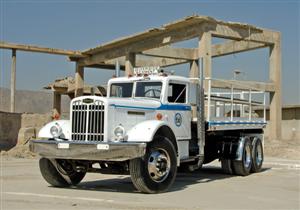 When
the company replaced these three trucks, they traded in the other two
and put #3 out in the Eucalyptus trees, where it sat for seven or eight
years. When the mine operation really got going, they pulled the truck
out of the weeds and equipped it with a special flatbed body with built-in
bench seating on each side. Throughout the 1960’s, the “Tour Truck” (as
it was called) was used to take local high school and college geology
students on tours around the plant and into the mine. It was also used
at that time to take crews of workers deep down into the mine. In the
1970’s, the truck was “retired” again into the weeds where it sat until
about eight years ago. At that time, it was decided to restore the rig
and make her look pretty so they could put it out on display at the Crestmore
facility, which is where it sits today. Once a month, the shop mechanics
service the truck, wash it and charge its four 6-volt batteries.
When
the company replaced these three trucks, they traded in the other two
and put #3 out in the Eucalyptus trees, where it sat for seven or eight
years. When the mine operation really got going, they pulled the truck
out of the weeds and equipped it with a special flatbed body with built-in
bench seating on each side. Throughout the 1960’s, the “Tour Truck” (as
it was called) was used to take local high school and college geology
students on tours around the plant and into the mine. It was also used
at that time to take crews of workers deep down into the mine. In the
1970’s, the truck was “retired” again into the weeds where it sat until
about eight years ago. At that time, it was decided to restore the rig
and make her look pretty so they could put it out on display at the Crestmore
facility, which is where it sits today. Once a month, the shop mechanics
service the truck, wash it and charge its four 6-volt batteries.
We’d like to thank everyone at Riverside Cement for allowing us access to their facility and the truck, and for all the invaluable information we were given by the many people we interviewed at the plant, including Diane Fionda, Mike Jordon, Ken McLaughlin and Mike Dickson. We’d also like to thank garage mechanic Tony Carraher for driving the truck around for us all day. Tony, who has worked at the plant since 2001, is a fourth generation employee of Riverside Cement. With the large demand for cement these days, a job at the plant offers steady work and great pay – you can’t beat that!
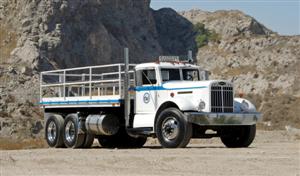 So
whether you are inclined to think that the limestone was the “white gold”
at Riverside Cement or this neat old truck with an interesting history,
we think you’ll be right either way. This Autocar wasn’t the prettiest
truck we’ve ever featured, but it sure was photogenic around that cement
plant. And if the world keeps building, which we’re pretty sure it will,
Riverside Cement just might enjoy 100 more years. Only time will tell.
So
whether you are inclined to think that the limestone was the “white gold”
at Riverside Cement or this neat old truck with an interesting history,
we think you’ll be right either way. This Autocar wasn’t the prettiest
truck we’ve ever featured, but it sure was photogenic around that cement
plant. And if the world keeps building, which we’re pretty sure it will,
Riverside Cement just might enjoy 100 more years. Only time will tell.
Copyright
© 2006 10-4 Magazine and Tenfourmagazine.com
PO Box 7377 Huntington Beach, CA, 92615 tel. (714) 378-9990 fax
(714) 962-8506

